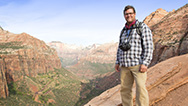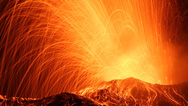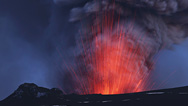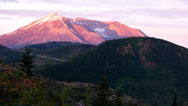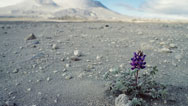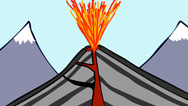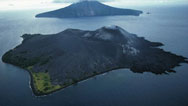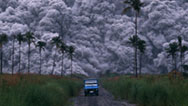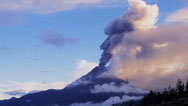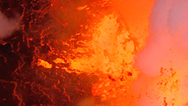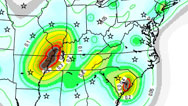
Mt St Helens: Back From the Dead
Thirty years after the massive eruption, could it happen again? Airing May 4, 2010 at 9 pm on PBS Aired May 4, 2010 on PBS

Program Description
Transcript
Mt. St. Helens: Back From the Dead
PBS Airdate: May 4, 2010
NARRATOR: Mount St. Helens: the biggest volcanic eruption in North America in nearly a century. Virtually all life for 200 square miles is wiped out. It seems impossible life could ever return to this barren wasteland.
CHARLIE CRISAFULLI (Ecologist, United States Department of Agriculture Forest Service): We found a lot of our conventional wisdom was just flat wrong.
NARRATOR: In recent years there are ominous signs the volcano is awakening.
JOHN PALLISTER (Geologist, United States Geological Survey): These things were like skyscrapers that were being shoved out of the ground. They were literally that big.
NARRATOR: A 30-year quest to understand one of the most complicated volcanoes in the world is revealing new mysteries, deep inside the mountain.
JOHN PALLISTER: We don't know whether it's going to erupt explosively again in two years or in 20 years or in 200 years.
NARRATOR: Is Mount St. Helens preparing to erupt again? Right now, on NOVA: Mount St. Helens: Back from the Dead.
October 2004: Mount St. Helens comes back to life. Steam and ash spew from the crater on the mountain's summit.
JOHN PALLISTER: We saw the boiling material come out of the ground. We saw that it was blasting up. It was dark and it was light at the same time. It made a plume that rose up over the rim of the caldera and drifted downwind. It came up to above our altitude, to 10- or 12,000 feet.
NARRATOR: It's a frightening development. For years, Mount St. Helens has been quiet.
JON MAJOR (Geologist, United States Geological Survey): The volcano went from quiet to unrest to eruption very, very rapidly.
NARRATOR: It could be headed for a massive explosion.
DANIEL DZURISIN: (Geologist, United States Geological Survey): It seemed possible that we were headed toward an explosive eruption. We didn't know. That was a key question.
NARRATOR: The effort to understand what is happening inside the mountain couldn't be more urgent. Is the volcano about to repeat the events of three decades earlier, when it shattered the tranquility of its peaceful surroundings?
Spring, 1980: Mount St. Helens is one of the major peaks in the Cascade Mountains. It's an area of outstanding beauty, rich in wildlife. For over 120 years, the volcano has been quiet, but in recent weeks it's been rumbling. Nobody is sure what to expect. Then, on May 18, 1980, a 5.1-magnitude earthquake rocks the mountain.
Within 10 seconds, the volcano's northern flank collapses in the largest landslide in recorded history. It releases millions of tons of magma, in a colossal explosion. A cloud of searing gas and rock, known as a pyroclastic flow, races over the surrounding countryside.
Forests are flattened. Four miles below the summit, an enormous lake is choked with debris. The eruption continues to shoot poisonous steam and ash miles into the air.
JOHN PALLISTER: It was just, again, astounding is the best word to describe what happened in 1980, here in Mount St. Helens.
NARRATOR: The northern slope of the mountain is buried in several feet of ash. Virtually all life is extinguished. Fifty-seven people are dead. They include loggers, campers, scientists and a reporter. Some are up to 13 miles away, in areas considered safe.
The plume of steam and ash rises miles into the sky, for the rest of the day. The drifting ash cloud disrupts air traffic for hundreds of miles. The scale of the destruction is enormous.
Across more than 200 square miles the surge of ash and rock incinerates trees. Thousands of birds, from more than a hundred species, disappear. Billions of insects are gone. Deer and elk are wiped out. This vast area of devastation becomes known as the blast, or blowdown, zone.
Nearer the crater, ash and rocks from the landslide litter the northern slope of the mountain. It looks like the moon. It's called the pumice plain. It's directly below the crater.
Four miles from the volcano, the enormous Spirit Lake is scarcely recognizable. The avalanche has lifted its bed more than 200 feet. The surface is smothered in dead trees. Hundreds of species of aquatic life, including insects, amphibians and fish, are killed.
CHARLIE CRISAFULLI: It was black water. And it de-gassed and bubbled, and there were hot springs that were coming up. If you were to put your fingers in, to your wrist, and wiggle them, you wouldn't even be able to see your fingertips. That's how grossly modified the water was.
NARRATOR: Mount St. Helens is now a lifeless jumble of shattered forest, rock and ash. It's hard to imagine life will ever return.
The eruption was so powerful, it's altered the shape of the mountain. Mount St. Helens was a typical cone-shaped volcano, known as a stratovolcano, but the landslide has torn 1,300 feet off the summit, leaving a gaping crater a mile wide and 2,000 feet deep. It's the largest volcanic eruption in North America in nearly a century.
Weeks after the eruption, scientists arrive at the crater. The volcano is still steaming and rumbling. It's a new and unfamiliar world.
One of the first to arrive is Dan Dzurisin.
DAN DZURISIN: There was a tremendous amount of steam, and you could see... It was very hot. You didn't see red lava oozing out of the ground; you didn't see fantastic fire fountains. There was this constant background roar of rocks cascading down the crater walls. Occasionally, a very large rock, the size of the helicopter, would come bouncing down, and you could watch it, and it was almost slow-motion, because the crater was so large.
NARRATOR: Mount St. Helens has a long history of eruptions. More than 500 years ago, two massive explosions took place within two years of each other. They were nearly four times larger than May 1980.
The mountain sits on one of the most active seismic zones in the world, the Pacific Ring of Fire, a vast arc of volcanoes running for thousands of miles. It's home to some of the biggest and most dangerous volcanoes active today. Here, the enormous plates making up the earth's crust are being squeezed together. Along the coast, the plate below the Pacific is sliding under the North American Plate. Sixty miles down, pressure and friction melt the rock; magma wells up. When it reaches the surface, it bursts out.
But there are still many unanswered questions. Scientists' understanding of what triggers an eruption this massive is incomplete. And given the scale of destruction, they need to find a way to predict when it might happen again, before it's too late. Mount St. Helens is about to become one of the most intensely studied volcanoes in the world.
The mysteries are not just geological. Biologists want to know if any life has survived and what its future will be.
Charlie Crisafulli, one of the leading experts on the mountain's ecology, arrives soon after the eruption.
CHARLIE CRISAFULLI: Nothing could have prepared me for the sights and sounds that I saw when I got here. It was complete and utter barrenness, and there was no sign of life whatsoever.
NARRATOR: His job is to survey the mountain looking for any living things.
CHARLIE CRISAFULLI: It was just intriguing to think about. How would life come back to this landscape? What would the patterns be? How would the rate be?
NARRATOR: Much of the mountain is still inaccessible, so he starts work in the blowdown zone, in an area some eight miles downhill from the crater.
CHARLIE CRISAFULLI: We flew over in a helicopter very close to the ground. We would have these bumping, twisting flights across the landscape following a contour.
NARRATOR: In the first three months, there's nothing but dead and uprooted trees. Then he notices something: signs of freshly disturbed earth.
CHARLIE CRISAFULLI: Lo and behold, on many occasions, brown earth on top of the grey volcanic ash.
NARRATOR: Is there something down there? Crisafulli returns on foot to investigate.
There, emerging from the ash, is a tiny burrowing animal. It's a northern pocket gopher.
CHARLIE CRISAFULLI: It was, er, very thrilling.
NARRATOR: How can it possibly have survived when nothing else has?
CHARLIE CRISAFULLI: This tiny animal lives entirely beneath the ground, so when the blast occurred, it would have been safely, uh, protected, beneath a mantel of soil, and may very well have survived in many locations.
NARRATOR: Over the following months, he finds more gophers. It appears that life is returning to the mountain, just three months after the eruption.
By fall, the volcano is still active. Plumes of steam and ash continue to shoot thousands of feet into the air, but something else is happening too. The crater floor appears to be moving. Is the mountain preparing for another major eruption?
DAN DZURISIN: We would sometimes notice a crack that hadn't been there the day before, and, by the end of the day, the crack was larger. And you realized that the ground was moving beneath your feet.
NARRATOR: It's an unsettling experience to stand on the floor of a volcano that's visibly moving.
DAN DZURISIN: If you stood and looked very, very, very carefully, with a reference point in the background, sometimes you could see it move, but just barely.
NARRATOR: The scientists set up a time-lapse camera on a nearby ridge.
Over several days, the pictures show a dome rising in the middle of the crater floor. The volcano is oozing a sticky gray lava, cooling as it reaches the surface.
Over several months, the dome grows larger. The geologists are puzzled. What is going on inside the mountain? Is Mount St. Helens simply rebuilding its summit, or is it about to blow up?
DAN DZURISIN: We didn't know what might come next, whether the lava might continue to grow for many years, or even decades or centuries. And we didn't know if there might be explosive eruptions in store.
NARRATOR: Then winter closes in, restricting access to the mountain. The scientists' work is limited. Answers will have to wait until spring.
Spring, 1981: nearly a year after the initial eruption, life returns to the hills and valleys of the Cascade Range, but on Mount St. Helens, the devastation of the previous year is still obvious.
Despite the danger, Crisafulli moves closer to the active volcano's core.
The pumice plain is buried in several feet of coarse ash. It's a dusty barren wilderness. Life seems impossible.
CHARLIE CRISAFULLI: This is an area where super-hot incandescent flows came down and killed all life that was here.
NARRATOR: Helicopter is the only way in.
CHARLIE CRISAFULLI: We were flying back and forth, very low, just above the ground surface, looking for any form of life.
NARRATOR: He crisscrosses the area, but there's nothing to see. Then, suddenly, amidst the acres of barren rock, there's an unexpected flash of color.
CHARLIE CRISAFULLI: So we set this helicopter down, and we walked up. Right out in the center of the pumice plain, we saw a plant.
NARRATOR: At first, Crisafulli can hardly believe his eyes.
CHARLIE CRISAFULLI: It was a prairie lupine, a species that typically grows high in the slopes of Mount St. Helens.
NARRATOR: It's not only growing, it's flourishing.
CHARLIE CRISAFULLI: Not only had the plant established, at that point it was in full flower. It was quite remarkable. When we saw the first one we were very surprised.
NARRATOR: It's only four miles from the volcano's crater. It's the first sign of life in an area where everything has been extinguished. But how has the plant managed to grow in such a barren area? The answer is a special root structure that provides its own fertilizer.
CHARLIE CRISAFULLI: These are little factories, where bacterium works with the plant and, um, provides nitrogen, um, to the plant. In return, the plant provides the bacterium with simple sugars, um, that it fixes through photosynthesis. And so, this is a great relationship, where you scratch my back, I'll scratch yours.
NARRATOR: This special process means lupines can grow in even the most inhospitable terrain. The lupine, like the gopher Charlie found earlier, is a pioneering species.
CHARLIE CRISAFULLI: It's really important in landscapes like Mount St Helens, because the volcanic material that fell on the ground tends to be really nutrient-poor.
NARRATOR: The conditions are difficult, but can the lupine pave the way for other life to follow?
In the spring, geologists also return to the mountain. During the winter months, lava has continued to ooze out of the crater floor.
The lava dome has grown several hundred feet taller and doubled in diameter. It's still a hazardous place.
DAN DZURISIN: When I stepped out of the helicopter, in 1981, on the crater floor, steam was actively rising off the, the growing lava dome. There was still a tremendous amount of noise. Rock falls were constant, and 2,000 feet above your head used to be where the summit of the volcano was. You were now standing in a crater with a lava dome that had not been there a few months previously or a year previously. It was actively steaming. That was a very, very exciting thought.
NARRATOR: It's a rare opportunity to watch the process of dome-building unfold in front of their eyes. The geologists set up instruments to monitor what's going on, including seismometers that can detect tremors set off by lava as it forces its way through the rocks. They place a series of these as close to the lava dome as possible.
At the Cascades Volcano Observatory, in southern Washington, the seismic data pours in.
DAN DZURISIN: A seismic record, like this, records any vibration of the ground, so we can see real rock-breaking earthquakes; we can see rock falls. It's our job to understand what all those signals mean, in terms of what the volcano might do.
NARRATOR: The first traces reflect extreme activity.
DAN DZURISIN: Here, you see the record is almost continuous, one earthquake after the other, bang, bang, bang. The seismic signal is, essentially, continuous.
NARRATOR: The lava is breaking through rocks and flowing across the crater floor.
Then, the seismic record reveals a cyclical pattern.
DAN DZURISIN: For periods of weeks to months, earthquake activity in the crater would be pretty quiet.
NARRATOR: The lava is no longer flowing.
DAN DZURISIN: And then, a few days later, ah, we might see a pattern like this: more and more of these very sharp earthquakes.
NARRATOR: It's the sign of lava on the move again, forcing its way through the ground.
DAN DZURISIN: Eventually, lava would make it onto the surface—maybe in just a couple of days—and we're seeing a continuous record of ground-shaking, both earthquakes and rock falls. Then, after a period of dome growth that might last a few days or a few weeks, it goes quiet again. That episode is ended, and the pattern begins itself over.
NARRATOR: This cycle of dome building continues for the next five years.
The pattern is so regular that when the cycle begins, the scientists can accurately predict what the volcano will do next. When the first rock-breaking earthquakes occur, they know it's only a matter of days or weeks before the lava starts to flow again.
At one point, the dome reaches nearly 1,000 feet, almost as high as the Empire State Building. Then, in late 1986, the seismographs go quiet.
DAN DZURISIN: It was pretty clear that that period of dome building had ended.
NARRATOR: But for how long? Has the mountain gone back to sleep?
JON MAJOR: It wasn't clear whether the mountain had, had gone back to sleep, now, for centuries, or whether it was going to just go back to sleep for a couple of years.
NARRATOR: It seems the pattern has changed. For six years, the scientists have been able to predict what the mountain will do next. Now they are back to guessing if and when it will erupt again.
But even if the volcano has gone to sleep, the wildlife continues to bounce back. More and more gophers are spreading across the blowdown zone; lupines are colonizing the pumice plain; and what's happening at Spirit Lake is remarkable.
The May, 1980, eruption obliterated all visible life in the lake. The surface was smothered in a blanket of debris. In the murky water, there was an explosion of bacteria.
CHARLIE CRISAFULLI: There were a couple of species of pne..., pneumonia that were described, and also the disease, the bacteria that causes legionnaires disease, legionella. And so, many of us working in the lakes, in the early days, came down with a fever.
NARRATOR: The bacteria rapidly consumed the oxygen, making life impossible for any air-breathing organisms including fish, amphibians and insects.
CHARLIE CRISAFULLI: We said it's going to be decades and decades before this resembles anything like a typical lake in the Cascade Mountain Range. Well, we were surprised, because that's not exactly what happened.
NARRATOR: Scientists begin routine water sampling. It's a unique opportunity to see if and when life will return from the dead.
At first there's nothing, but as the debris settles, the water clears, light levels improve. Then, three years after the eruption, there's a crucial discovery: microscopic plants. They're phytoplankton, plants that turn sunlight into oxygen.
They've been brought in by birds or blown in by the wind. They are the basic building block of aquatic life.
Over the following months, as light levels continue to improve, the plankton population grows.
CHARLIE CRISAFULLI: In fact, between 1983 and 1986, 135 different species of these tiny plants had colonized the lake. They provide the oxygen and also the prey for the food web.
NARRATOR: Sunlight, oxygen and food; several years after its complete destruction, Spirit Lake is coming back to life.
Four miles away, the volcano remains quiet. The lava dome has stopped growing. Many geologists think the show is over, at least in their lifetime.
DAN DZURISIN: We had the feeling that we had probably seen our last eruption at Mount St Helens. We knew there was a chance it would erupt again, but none of us were betting on it.
NARRATOR: As the mountain sleeps, wildlife bounces back, even in the most unexpected places. In one of the most devastated areas of the mountain, the pumice plain, a gopher is seen. It's surviving by eating lupine.
Lupines provide the food; gophers enrich the pumice by burrowing their way through the ash. They mix in fresh soil and help new plants to spread.
CHARLIE CRISAFULLI: When you walked around the landscape, it was those islands created by gopher-turned soils that were very green and full of flower and seeds.
NARRATOR: The gophers also play another role in helping wildlife spread.
Charlie Crisafulli finds a salamander in a gopher's tunnel.
CHARLIE CRISAFULLI: What's interesting about the gopher is they create kilometers of underground tunnel systems.
NARRATOR: Elk are also returning to the area, helping to expand this amazing web of life.
CHARLIE CRISAFULLI: When elk move across the landscape, they collapse the tunnels, creating entrance ways that salamanders and other amphibians can get access to. And once they get beneath the ground, these are very cool and moist sites that enable them to survive in an otherwise inhospitable area. And the importance of that is that it allows them to use these underground burrows as stepping stones during hot, dry weather and eventually to colonize new patches of terrestrial habitat, as well as ponds and lakes.
NARRATOR: Spirit Lake now teems with amphibians.
Fish, put into the lake by fishermen, are thriving, a clear indication that the water quality is returning to normal.
CHARLIE CRISAFULLI: What's happened with the fish was actually remarkable, and, while we don't have a good handle on the total number of fish, we know from our snorkeling and, and our survey that the population is enormous.
NARRATOR: Spirit Lake is beginning to resemble a typical mountain lake. Just over a decade after the eruption, life is flooding back to the slopes of Mount St. Helens. The rate of recovery is far faster than anybody had expected.
CHARLIE CRISAFULLI: Clearly, our understanding of the ability of these organisms to disperse was greatly underappreciated. We found a lot of our conventional wisdom was just flat wrong.
NARRATOR: Then, as life recovers, new threats emerge.
In September, 2004, the seismographs at the Cascades Volcano Observatory pick up a new series of tremors, deep below Mount St. Helens. The volcano has woken up. John Pallister takes a helicopter to investigate.
JOHN PALLISTER: You could see the absolute beginning of the eruptions, unusual, really unusual, to just happen to be there, in a helicopter, at the crater rim, on the upwind side, so the plume was going away from us.
NARRATOR: Pallister has no idea how big this eruption will be.
JOHN PALLISTER: We saw the boiling material come out of the ground. We saw that it was blasting up. It was dark ash coming out and light steam coming out at the same time. It made a plume that rose up over the rim of the caldera and drifted downwind.
NARRATOR: The speed and suddenness of the eruption catches everybody by surprise.
JON MAJOR: The volcano went from quiet to unrest to eruption very, very rapidly.
NARRATOR: During the next two weeks there are three more eruptions of steam and ash. No one knows what will happen next.
DAN DZURISIN: It seemed possible that we were headed toward an explosive eruption. We didn't know. That was a key question.
NARRATOR: Then, after 14 days, the seismographs quiet down.
Almost as quickly as it started, the eruption stops. But then something strange happens. Over the next few weeks, the seismographs pick up a new pattern of tremors the geologists have never seen before.
Could they be linked to a gigantic lump of lava growing out of the crater floor?
JOHN PALLISTER: It was a huge kind of recumbent spine, this big mass lying in the crater floor some 300 meters, or so, high.
NARRATOR: The spine of lava is as long as the Eiffel Tower.
JON MAJOR: Everybody was just awestruck. To have this large spine just shoving up out of the ground was completely different and outside the experience of any of us here in the staff.
NARRATOR: Despite the risk, John Pallister goes in to take samples.
JOHN PALLISTER: We landed right next to it, and I was able to get out, helicopter helmet on, rapidly run up to the edge of the spine.
NARRATOR: It's an unbelievable sight.
DAN DZURISIN: Had someone suggested to me that we make a movie of a lava dome growing that way, I think I would have said, "It's a little too fantastic, let's make it more realistic."
NARRATOR: At the observatory, where geologists have been puzzling over the strange seismic traces, they now realize what they are: they're the unique autograph of the giant spines as they push their way out of the ground.
DAN DZURISIN: This is the seismic signature of solid blocks of rock, grinding their way through the volcano, coming out onto the surface. As they do, they make these small, seismic signals, one just like the other, just like the other, very repetitive. We came to call them drumbeats.
NARRATOR: The drumbeats continue for several years. Spine after spine of solid lava emerges from the crater floor. It's unlike anything geologists have seen on Mount St. Helens.
JOHN PALLISTER: Now, "spine" doesn't do justice to these things. These things were like skyscrapers that were being shoved out of the ground. They were literally that big.
NARRATOR: Sometimes the blocks grow at a rate of 16 feet a day. Then they collapse. Seen through a time-lapse camera, one solid lump of lava after another pushes up through the crater floor. The process is mystifying. What do the spines mean?
JON MAJOR: Why was the eruption in 2004 so different than the style of eruption in the 1980s? Why, in the 1980s, did you have this more fluid lava that created the sort of short, stubby lava flows that came out and built a lava dome, whereas, in 2004, you basically had solid rock being pushed up in the ground?
NARRATOR: There's one urgent question: is the volcano building up to another major eruption?
JON MAJOR: Trying to make sense of what was going on was a challenge. Trying to understand how the eruption was going to progress was a challenge. We had lots of discussions about whether or not it was going to be an explosive eruption, whether it was going to be another dome-building eruption.
NARRATOR: There is one way to find out. Analyzing samples of the lava might explain the mysterious solid blocks and what they mean for the future. At the volcano observatory, John Pallister compares lava from the spines with samples taken from previous eruptions. Could there be something in their composition that explains why the mountain sometimes pushes up spines, sometimes oozes lava and sometimes explodes?
Pallister begins with a sample of the lava that erupted so explosively in May, 1980. He's immediately struck by the large areas of blue.
JOHN PALLISTER: Okay, so, what's important about this 1980 rock is the abundance of this blue area, and that's, basically, bubbles. That's not a mineral. That's just open space in the thin section. That's where gas bubbles were. This sample would float in water it had so much gas in it.
NARRATOR: The gas comes from water, a component of the magma. As magma rises, changes in pressure turn the water into gas. The gas pressurizes the magma. It's what gives volcanoes their explosive force.
JOHN PALLISTER: 1980 had a lot of gas in it, so it exploded, tore itself apart in a tremendous explosive eruption.
NARRATOR: But, when he looks at lava taken from the 1983 period of dome-building, it's different.
JOHN PALLISTER: There is much less of this open space, of the gas-filling space in the rock.
NARRATOR: The 1983 lava behaves like a bottle of soda going flat.
Finally, he looks at a sample of lava from one of the spines in 2005.
JOHN PALLISTER: I don't see any blue space, any of that. Oh, there's just a little bit, but, dominantly, it is, it is lacking in space. It's a gas-poor magma. In fact, almost none.
NARRATOR: There's just enough gas to push it to the surface, but by the time it gets there, there is nothing left.
JOHN PALLISTER: So this one came up slow, and it made sticky, solidified spines, instead of making either lava flows or an explosive eruption.
NARRATOR: It's a crucial insight: the amount of gas determines the nature of the lava and the force of the eruption.
JOHN PALLISTER: It all comes to the gas budget for the eruption: is it going to fizzle or is it going to explode?
NARRATOR: Suddenly, the mountain's behavior makes sense. The spines are a sign the magma under Mount St. Helens is running low on gas. Then in 2007, as if to confirm this new insight, the familiar drumbeat seismic traces vanish completely. No more spines appear. The lava below the mountain has finally run out of gas.
How long will it take the mountain to build up enough gas pressure for another eruption?
JOHN PALLISTER: I think that is the most important question we have to answer: "How long does it take to build up the gas necessary to drive an explosive eruption?"
NARRATOR: That's now the question they need to answer. Geologists go back to the mountain to look for clues.
The eruption in 1980 took the top off Mount St. Helens, leaving its history exposed in the rock walls of the crater. Most of the important previous eruptions are marked by different colored bands.
JON MAJOR: The lower part of the walls, where you see gray and some yellows and some pinks, are all part of the older edifice of Mount St. Helens.
NARRATOR: These rocks, which make up the bottom half of the rock face, are around 16,000 years old.
JON MAJOR: Then, if you look higher on the wall, near the top, you see darker colors. Those are rocks that began erupting about 3,000 to 2,500 years ago. So, by looking at the, what we call the stratigraphy, in this magnificent exposure of the rock types in the crater walls, we can piece back, uh, sort of, the puzzle and understand the history, as far as...eruptive history of Mount St. Helens.
NARRATOR: Do the rocks give any indication of how long it takes to build up enough gas, between eruptions, for the sleepy mountain to awake again?
John Pallister sorts and categorizes rocks from earlier eruptions. He checks notes and photos to try and determine how often the mountain has erupted violently. Drawing on previous records, he builds up a picture of Mount St. Helens' past. For much of the last 4,000 years, there seems to be a fairly clear pattern.
JOHN PALLISTER: If we look at the number of big eruptions, over the length of time the volcano's been active, you might say that there's one roughly every thousand years, a big eruption. So, um, from our context, here, we could say that it takes on the order of a thousand years to build up enough gas to get a really large eruption.
NARRATOR: The record suggests some of these eruptions have been huge, more than 10 times larger than 1980, potentially enveloping vast areas of Washington and Oregon. But that would imply that the next really big one isn't due for about another century, except for one little detail, around 500 years ago.
JOHN PALLISTER: In 1479, A.D., and 1482, there were two very large eruptions. So the volcano is capable of surprising us and producing two highly explosive eruptions in a span of less than three years.
NARRATOR: Both these eruptions were much bigger than May, 1980. There is no straightforward pattern. Mount St. Helens can pause for a thousand years between big explosive eruptions or it can pause for three.
These results have left geologists with one certainty and a number of questions.
JOHN PALLISTER: First of all, we expect this volcano to erupt again, as repeatedly as in the past. There's no reason to think it's gone to sleep forever, now.
NARRATOR: There will be another eruption, but nobody can determine when or just how big it will be.
JOHN PALLISTER: We don't know whether it's going to erupt explosively again in two years or in 20 years or in 200 years. That is an area that needs a lot more work, a lot more research to understand. And it is of fundamental importance to enable to forecast and to save lives and to save property.
NARRATOR: For 30 years, Mount St. Helens has led scientists on an extraordinary journey of surprise and discovery. When they surveyed the destruction in the early 1980s, nobody could have predicted the speed with which life has returned.
CHARLIE CRISAFULLI: It was another form of an eruption; it was an eruption of nature. Nature marched back with a vengeance.
NARRATOR: Mount St. Helens has revealed a rich and complex web of life that has never been documented before. Today, the slopes of the mountain are a living testimony to the miraculous ability of nature to return from the dead.
CHARLIE CRISAFULLI: Each time, you would come out here and it, there would be a surprise, something would be unveiled, something that you hadn't seen before. Perhaps it would be a new species of spider, a new species of beetle. Nature is very resilient, and that is the take-home message from 30 years of ecological work on the Mount St. Helens volcano.
NARRATOR: But as nature bounces back, the mountain still broods overhead. It's like a ticking time bomb waiting to destroy life all over again.
JON MAJOR: Based on the history of this volcano, we know it has been extremely active, and it's not a matter of if it will erupt again; it's a matter of when it will erupt again. When will it reactivate? When will it reawaken?
NARRATOR: These are questions scientists are still wrestling with.
DAN DZURISIN: We have yet to find a silver bullet, a magic thing that we can measure that tells us when the volcano is going to turn on.
NARRATOR: Mount St. Helens will erupt again. The only questions are when and how big that eruption will be.
Broadcast Credits
Mt. St. Helens: Back From the Dead
- Executive Producer
- Matthew Barrett
- Written, Produced, and Directed by
- Nick Davidson
- Associate Producer
- Sascha Olofson
- Edited by
- Martin Sage
- Additional Edited by
- Rob Alexander
- Narrator
- Lance Lewman
- Photography
- Mark Molesworth
Josef Neuper - Additional Photography
- Michael Bendixen
- Underwater Photography
- Erich Pröll
- Cineflex Operator
- Thomas Miller
- Camera Assistants
- Martin Stoni
Jutta Wirth - Sound Recordist
- Donna Molesworth
- Music
- Mark Adair
- Animation
- Prime Focus
- Location Manager
- Sabine Sporer
- Unit Manager
- Eleonora Frey
- Production Managers
- Judy Evans
Dinah Czezik-Müller - Archivist
- Cristina Miro
- Online Editor
- David Grewal
- Colorists
- Peter Lynch
David Hughes - Audio Mix
- Greg Gettens
- Scientific Advisors
- Charlie M. Crisafulli
Jon J. Major - Archival Material
- BBC Motion Gallery
U.S. Geological Survey
IMAX
Graphic Films Corporation
Oregon Public Broadcasting - Photo Library
- Gary Braasch
Joel Harvey
John Marshall - Special Thanks
- Mount St. Helens National Volcanic Monument
Tom Mulder
US Forest Service
Peter Frenzen
U.S. Geological Survey Cascades Volcano Observatory
Austrian Agency for Health and Food Safety
Natural History Museum Vienna - For Orf Universum
- Mount St. Helens
- Life From Zero
- Written and Directed by
- Jörg Daniel Hissen
Heinz Leger - Produced by
- Heinrich Mayer
- Music Composed by
- Roman Kariolou
- Narration Script
- Klaus Feichtenberger
- Editor
- Sebastian Würger
- Digital Visual Effects
- Industrial Motion Art
- Graphic Design
- Daniel Budka
Katharina Geiger - Sound Design and Mix
- Michael Plöderl
Bernd Dormayer
Thomas Kathriner - Co-Producer
- Martin Pieper
- Executive Producers
- Walter Köhler
Rudolf Klingohr - NOVA Series Graphics
- yU + co.
- NOVA Theme Music
- Walter Werzowa
John Luker
Musikvergnuegen, Inc. - Additional NOVA Theme Music
- Ray Loring
Rob Morsberger - Post Production Online Editor
- Spencer Gentry
- Closed Captioning
- The Caption Center
- Publicity
- Carole McFall
Eileen Campion
Victoria Louie
Karen Laverty - Marketing
- Steve Sears
- Researcher
- Kate Becker
- Production Coordinator
- Linda Callahan
- Paralegal
- Sarah Erlandson
- Talent Relations
- Scott Kardel, Esq.
Janice Flood - Legal Counsel
- Susan Rosen
- Production Assistant
- Ryan Murdock
- Post Production Assistant
- Darcy Forlenza
- Associate Producer, Post Production
- Patrick Carey
- Post Production Supervisor
- Regina O'Toole
- Post Production Editor
- Rebecca Nieto
- Post Production Manager
- Nathan Gunner
- Compliance Manager
- Linzy Emery
- Development Producer
- Pamela Rosenstein
- Supervising Producer
- Stephen Sweigart
- Business Manager
- Joseph P. Tracy
- Senior Producer and Project Director
- Lisa Mirowitz
- Coordinating Producer
- Laurie Cahalane
- Senior Science Editor
- Evan Hadingham
- Senior Series Producer
- Melanie Wallace
- Executive Producer
- Howard Swartz
- Managing Director
- Alan Ritsko
- Senior Executive Producer
- Paula S. Apsell
- Charlie Crisafulli
- Ecologist, USDA Forest Service www.fs.fed.us/
- Daniel Dzurisin
- Geologist, USGS volcanoes.usgs.gov/insar/dz.php
- Jon Major
- Geologist, USGS vulcan.wr.usgs.gov/Projects/JJMajor/framework.html
- John Pallister
- Geologist, USGS
A NOVA/ORF co-production by Interspot for WGBH Boston in association with ZDF/ARTE, BMUKK, Fremantle Media, supported by Fernsehfonds Austria.
Participants
Preview
Full Program | 53:08
Full program available for streaming through
Watch Online
Full program available
Soon

